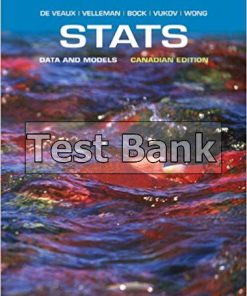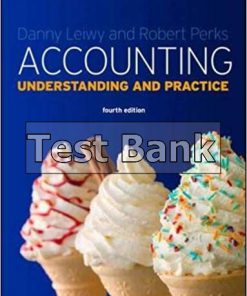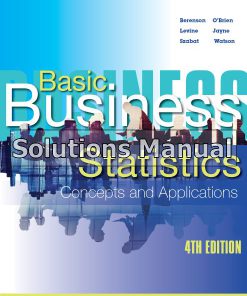Stats Data and Models 4th Edition De Veaux Solutions Manual
You may also like
-
$26.50
$50.00
Stats Data and Models 4th Edition De Veaux Solutions Manual

Product details:
- ISBN-10 : 0321986490
- ISBN-13 : 978-0321986498
- Author: Richard D. DeVeaux
Richard De Veaux, Paul Velleman, and David Bock wrote Stats: Data and Models with the goal that students and instructors have as much fun reading it as they did writing it. Maintaining a conversational, humorous, and informal writing style, this new edition engages students from the first page. The authors focus on statistical thinking throughout the text and rely on technology for calculations. As a result, students can focus on developing their conceptual understanding. Innovative Think/Show/Tell examples give students a problem-solving framework and, more importantly, a way to think through any statistics problem and present their results. The Fourth Edition is updated with instructor podcasts, video lectures, and new examples to keep material fresh, current, and relevant to today’s students.
Table contents:
Part I: Exploring and Understanding Data
1. Stats Starts Here
1.1 What Is Statistics?
1.2 Data
1.3 Variables
2. Displaying and Describing Categorical Data
2.1 Summarizing and Displaying a Single Categorical variable
2.2 Exploring the Relationship Between Two Categorical variables
3. Displaying and Summarizing Quantitative Data
3.1 Displaying quantitative variables
3.2 Shape
3.3 Center
3.4 Spread
3.5 Boxplots and 5-Number Summaries
3.6 The Center of Symmetric Distributions: The Mean
3.7 The Spread of Symmetric Distributions: The Standard Deviation
3.8 Summary—What to Tell About a quantitative variable
4. Understanding and Comparing Distributions
4.1 Comparing Groups with Histograms
4.2 Comparing Groups with Boxplots
4.3 Outliers
4.4 Timeplots: Order, Please!
4.5 Re-Expressing Data: A First Look
5. The Standard Deviation as a Ruler and the Normal Model
5.1 Standardizing with z-Scores
5.2 Shifting and Scaling
5.3 Normal Models
5.4 Finding Normal Percentiles
5.5 Normal Probability Plots
Part II: Exploring Relationships Between Variables
6. Scatterplots, Association, and Correlation
6.1 Scatterplots
6.2 Correlation
6.3 Warning: Correlation ≠ Causation
6.4 Straightening Scatterplots
7. Linear Regression
7.1 Least Squares: The Line of “Best Fit”
7.2 The Linear Model
7.3 Finding the Least Squares Line
7.4 Regression to the Mean
7.5 Examining the Residuals
7.6 R2—The variation Accounted For by the Model
7.7 Regression Assumptions and Conditions
8. Regression Wisdom
8.1 Examining Residuals
8.2 Extrapolation: Reaching Beyond the Data
8.3 Outliers, Leverage, and Influence
8.4 Lurking variables and Causation
8.5 Working with Summary values
9. Re-expressing Data: Get It Straight!
9.1 Straightening Scatterplots – The Four Goals
9.2 Finding a Good Re-Expression
Part III: Gathering Data
10. Understanding Randomness
10.1 What Is Randomness?
10.2 Simulating by Hand
11. Sample Surveys
11.1 The Three Big Ideas of Sampling
11.2 Populations and Parameters
11.3 Simple Random Samples
11.4 Other Sampling Designs
11.5 From the Population to the Sample: You Can’t Always Get What You Want
11.6 The valid Survey
11.7 Common Sampling Mistakes, or How to Sample Badly
12. Experiments and Observational Studies
12.1 Observational Studies
12.2 Randomized, Comparative Experiments
12.3 The Four Principles of Experimental Design
12.4 Control Treatments
12.5 Blocking
12.6 Confounding
Part IV: Randomness and Probability
13. From Randomness to Probability
13.1 Random Phenomena
13.2 Modeling Probability
13.3 Formal Probability
14. Probability Rules!
14.1 The General Addition Rule
14.2 Conditional Probability and the General Multiplication Rule
14.3 Independence
14.4 Picturing Probability: Tables, Venn Diagrams, and Trees
14.5 Reversing the Conditioning and Bayes’ Rule
15. Random Variables
15.1 Center: The Expected value
15.2 Spread: The Standard Deviation
15.3 Shifting and Combining Random variables
15.4 Continuous Random variables
16. Probability Models
16.1 Bernoulli Trials
16.2 The Geometric Model
16.3 The Binomial Model
16.4 Approximating the Binomial with a Normal Model
16.5 The Continuity Correction
16.6 The Poisson Model
16.7 Other Continuous Random Variables: The Uniform and the Exponential
Part V: From the Data at Hand to the World at Large
17. Sampling Distribution Models
17.1 Sampling Distribution of a Proportion
17.2 When Does the Normal Model Work? Assumptions and Conditions
17.3 The Sampling Distribution of Other Statistics
17.4 The Central Limit Theorem: The Fundamental Theorem of Statistics
17.5 Sampling Distributions: A Summary
18. Confidence Intervals for Proportions
18.1 A Confidence Interval
18.2 Interpreting Confidence Intervals: What Does 95% Confidence Really Mean?
18.3 Margin of Error: Certainty vs. Precision
18.4 Assumptions and Conditions
19. Testing Hypotheses About Proportions
19.1 Hypotheses
19.2 P-values
19.3 The Reasoning of Hypothesis Testing
19.4 Alternative Alternatives
19.5 P-values and Decisions: What to Tell About a Hypothesis Test
20. Inferences About Means
20.1 Getting Started: The Central Limit Theorem (Again)
20.2 Gosset’s t
20.3 Interpreting Confidence Intervals
20.4 A Hypothesis Test for the Mean
20.5 Choosing the Sample Size
21. More About Tests and Intervals
21.1 Choosing Hypotheses
21.2 How to Think About P-values
21.3 Alpha Levels
21.4 Critical values for Hypothesis Tests
21.5 Errors
Part VI: Accessing Associations Between Variables
22. Comparing Groups
22.1 The Standard Deviation of a Difference
22.2 Assumptions and Conditions for Comparing Proportions
22.3 A Confidence Interval for the Difference Between Two Proportions
22.4 The Two Sample z-Test: Testing for the Difference Between Proportions
22.5 A Confidence Interval for the Difference Between Two Means
22.6 The Two-Sample t-Test: Testing for the Difference Between Two Means
22.7 The Pooled t-Test: Everyone into the Pool?
23. Paired Samples and Blocks
23.1 Paired Data
23.2 Assumptions and Conditions
23.3 Confidence Intervals for Matched Pairs
23.4 Blocking
24. Comparing Counts
24.1 Goodness-of-Fit Tests
24.2 Chi-Square Test of Homogeneity
24.3 Examining the Residuals
24.4 Chi-Square Test of Independence
25. Inferences for Regression
25.1 The Population and the Sample
25.2 Assumptions and Conditions
25.3 Intuition About Regression Inference
25.4 Regression Inference
25.5 Standard Errors for Predicted values
25.6 Confidence Intervals for Predicted values
25.7 Logistic Regression
Part VII: Inference When Variables Are Related
26. Analysis of Variance
26.1 Testing Whether the Means of Several Groups Are Equal
26.2 The ANOVA Table
26.3 Assumptions and Conditions
26.4 Comparing Means
26.5 ANOVA on Observational Data
27. Multifactor Analysis of Variance
27.1 A Two Factor ANOVA Model
27.2 Assumptions and Conditions
27.3 Interactions
28. Multiple Regression
28.1 What Is Multiple Regression?
28.2 Interpreting Multiple Regression Coefficients
28.3 The Multiple Regression Model—Assumptions and Conditions
28.4 Multiple Regression Inference
28.5 Comparing Multiple Regression Models
29. Multiple Regression Wisdom
29.1 Indicators
29.2 Diagnosing Regression Models: Looking at the Cases
29.3 Building Multiple Regression Models
29.4 Building Multiple Regression Models Sequentially
Appendixes
A: Answers
B: Photo Acknowledgments
C: Index
D: Tables and Selected Formulas
People also search:
Stats Data and Models 4th
Stats Data and Models 4th Edition
Stats Data and Models 4th Edition De Veaux
Stats Data and Models 4th Edition De Veaux download scribd
Stats Data and Models 4th Edition De Veaux pdf free












